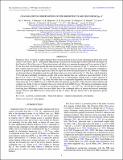CHANDRA/HETGS OBSERVATIONS OF THE BRIGHTEST FLARE SEEN FROM Sgr A*
Author(s)
Markoff, Sera B.; Porquet, D.; Grosso, N.; Levin, Y.; Eckart, A.; Falcke, Heino; Ji, L.; Miller, J. M.; Wang, Q. D.; Nowak, Michael A.; Neilsen, Joseph M. G.; Baganoff, Frederick K.; Houck, John C.; ... Show more Show less
DownloadNowak-2012-Chandra_HETGS observ.pdf (638.1Kb)
PUBLISHER_POLICY
Publisher Policy
Article is made available in accordance with the publisher's policy and may be subject to US copyright law. Please refer to the publisher's site for terms of use.
Terms of use
Metadata
Show full item recordAbstract
Starting in 2012, we began an unprecedented observational program focused on the supermassive black hole in the center of our Galaxy, Sgr A*, utilizing the High Energy Transmission Grating Spectrometer (HETGS) instrument on the Chandra X-Ray Observatory. These observations will allow us to measure the quiescent X-ray spectra of Sgr A* for the first time at both high spatial and spectral resolution. The X-ray emission of Sgr A*, however, is known to flare roughly daily by factors of a few to ten times over quiescent emission levels, with rarer flares extending to factors of greater than 100 times quiescence. Here we report an observation performed on 2012 February 9 wherein we detected what are the highest peak flux and fluence flare ever observed from Sgr A*. The flare, which lasted for 5.6 ks and had a decidedly asymmetric profile with a faster decline than rise, achieved a mean absorbed 2-8 keV flux of (8.5 ± 0.9) × 10[superscript –12] erg cm[superscript –2] s[superscript –1]. The peak flux was 2.5 times higher, and the total 2-10 keV emission of the event was approximately 10[superscript 39] erg. Only one other flare of comparable magnitude, but shorter duration, has been observed in Sgr A* by XMM-Newton in 2002 October. We perform spectral fits of this Chandra-observed flare and compare our results to the two brightest flares ever observed with XMM-Newton. We find good agreement among the fitted spectral slopes (Γ ~ 2) and X-ray absorbing columns (N [subscript H] ~ 15 × 10[superscript 22] cm[superscript –2]) for all three of these events, resolving prior differences (which are most likely due to the combined effects of pileup and spectral modeling) among Chandra and XMM-Newton observations of Sgr A* flares. We also discuss fits to the quiescent spectra of Sgr A*.
Date issued
2012-10Department
MIT Kavli Institute for Astrophysics and Space ResearchJournal
The Astrophysical Journal
Publisher
IOP Publishing
Citation
Nowak, M. A., J. Neilsen, S. B. Markoff, F. K. Baganoff, D. Porquet, N. Grosso, Y. Levin, et al. “CHANDRA/HETGS OBSERVATIONS OF THE BRIGHTEST FLARE SEEN FROM Sgr A*.” The Astrophysical Journal 759, no. 2 (October 23, 2012): 95. © 2012 The American Astronomical Society
Version: Final published version
ISSN
0004-637X
1538-4357